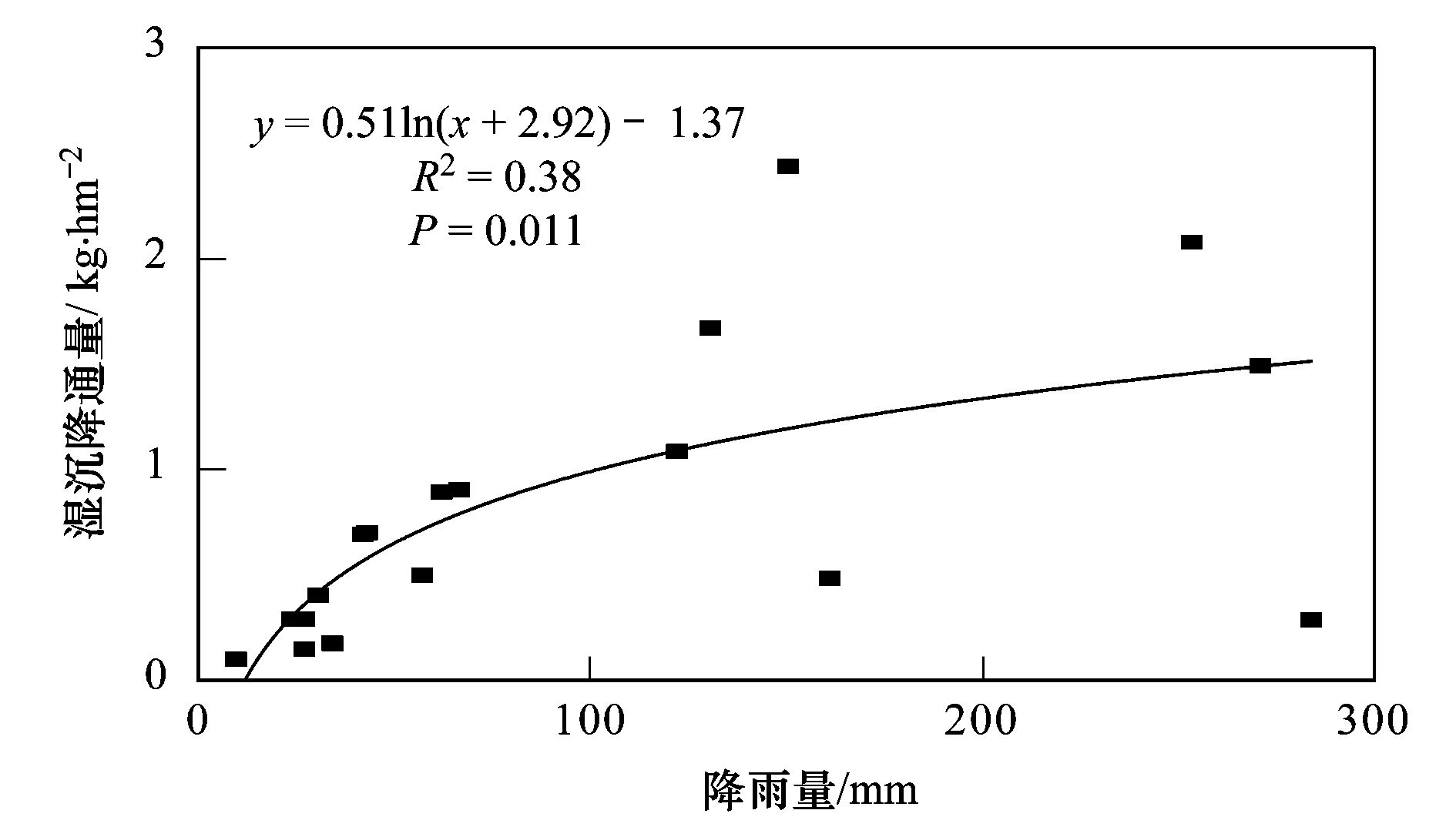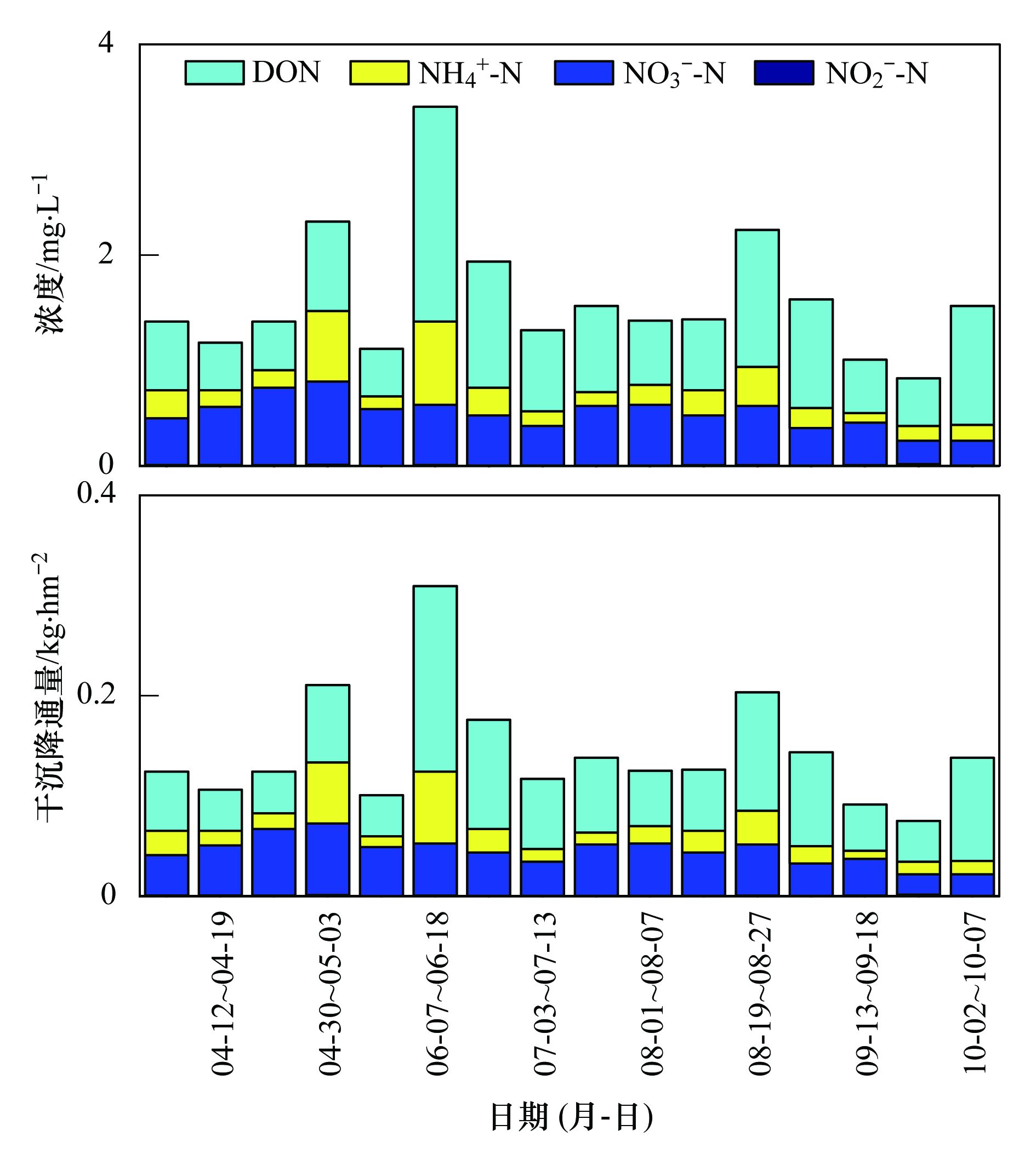2. 戴云山国家级自然保护区管理局, 德化 362500;
3. 江苏省地理信息资源开发与利用协同创新中心, 南京 210023;
4. 江苏省地理环境演化国家重点实验室培育建设点, 南京 210023;
5. 南京师范大学虚拟地理环境教育部重点实验室, 南京 210023
2. Daiyun Mountain National Nature Reserve, Dehua 362500, China;
3. Jiangsu Center for Collaborative Innovation in Geographical Information Resource Development and Application, Nanjing 210023, China;
4. State Key Laboratory Cultivation Base of Geographical Environment Evolution, Nanjing 210023, China;
5. Key Laboratory of Virtual Geographic Environment, Ministry of Education, Nanjing Normal University, Nanjing 210023, China
氮素是植物生长所需的必要营养元素之一[1],同时也是控制生态系统中物种组成与多样性、 影响生态系统稳定性及其功能的关键因子[2]. 在地球表面的大部分生态系统中,尤其是温带及北方森林,植被生长及微生物量的累积过程都受氮素供应的限制[3, 4]. 由于大量施用氮肥、 化石燃料燃烧等人类活动的影响,大气中含氮化合物浓度明显增加,因而导致氮沉降量增加[5~11]. 对于“氮限制”生态系统,短期、 少量的氮沉降能够增加生态系统中可利用氮数量,有利于提高生态系统生产力以及植被生物量的累积[4]. 因此,氮沉降是一种有利但有限的养分来源,表现出一定的施肥作用. 当持续、 大量的氮沉降超过了生态系统中植物和微生物对氮素的需求,系统将达到氮饱和状态[12, 13]. 过量的氮沉降可能造成水体酸化与富营养化[14~16]、 生物多样性降低[17, 18]、 森林衰退[19~21]等负面效应,对生态系统的结构和功能造成严重影响. 因此,定量一个生态系统中大气氮沉降通量对于评估当地生态系统安全以及氮素生物地球化学循环过程具有重要意义.
本文以福建戴云山国家级自然保护区为研究对象,利用干湿沉降采集器持续观测当地大气氮素干、 湿沉降,调查不同形态氮素在总氮沉降中的比例,以期为评价大气氮沉降对当地生态系统的影响提供科学依据,同时也为全国范围内调查大气氮沉降的时空分布与长期变化趋势积累基础数据.
1 材料与方法 1.1 研究区介绍本研究地点设在福建省德化县赤水镇境内的戴云山国家级自然保护区赤水管理所(25°38′26″N,118°8′26″E). 赤水镇位于德化县西北部,拥有杉、 松以及毛竹等林竹资源,森林覆盖率为51.5%. 全镇地势较高,海拔970 m,属于亚热带海洋性季风气候,夏季凉爽,冬季有霜或者下雪,年平均气温17℃. 每年有雾期达140 d左右,有霜期达165 d左右. 根据保护区内九仙山气象站资料记录,保护区年平均降雨量1700~2000 mm,降雨集中在每年生长季的3~9月,湿度较大,年相对湿度平均在80%以上,常年阴雨较多,日照较少. 观测时段为降雨集中的2015-03-27~2015-10-09.
1.2 采样方法采样仪器为美国New Star Environmental LLC公司的G78干湿沉降采集器,该仪器拥有独立的干、 湿沉降收集桶(11.4 L),采用梳状传感器,具有恒温加热功能,自动判断降雨情况,抗干扰能力强、 灵敏度高.
晴天时,仪器的传感器处于关闭状态,挡板将湿沉降采样桶密封罩住,干沉降采样桶收集大气干沉降样品(颗粒态). 降水发生时,传感器自动打开,通过双臂四连杆结构带动齿轮转动,挡板将干沉降采样桶密封罩住,湿沉降采样桶开始收集降水样品. 降雨停止10 min后,挡板自动转回再次密封罩住湿沉降采样桶,防止大气降尘和飘尘对湿沉降样品的污染,同时仪器开始继续收集干沉降样品. 大气干沉降一般监测7~10 d后采集一次样品,样品采用湿法收集,用500 mL的去离子水多次冲洗干沉降收集桶,待样品与洗液充分混合后取适量混合液于预处理的50 mL聚乙烯瓶中,编号后密封、 放入冰箱冷冻储藏、 待测. 湿沉降样品在每次降水事件发生的次日09:00~10:00之间收集,采集前需先记录降水量,之后将湿沉降收集桶内的降水样品摇匀,同样取适量于聚乙烯瓶中并冷冻保存待测.
1.3 样品分析大气氮干、 湿沉降样品采用流动分析仪(Skalar,Breda,Netherlands)测定铵态氮(NH4+-N)、 硝态氮(NO3--N)、 亚硝态氮(NO2--N)和全氮(TN)浓度. 其中可溶性无机氮(DIN)浓度为铵态氮、 硝态氮及亚硝态氮之和,可溶性有机氮(DON)浓度为全氮和无机氮浓度之差.
1.4 数据处理大气氮素湿沉降通量的计算方法:

|
(1) |
式中,Dwp代表氮素湿沉降的通量(kg·hm-2); ci为每次降雨中氮浓度(mg·L-1); Pi为每次降雨的降水量(mm); 100代表公式中单位转换系数.
大气氮素干沉降通量的计算方法:

|
(2) |
式中,Ddp代表氮素干沉降通量(kg·hm-2); ci湿法收集大气干沉降样品中氮素浓度(mg·L-1); L为每次湿法收集干沉降样品消耗去离子水的体积(500 mL); S为干沉降采集桶的底面积(m2); 100代表公式中单位转换系数.
相关统计分析在Windows SPSS 19.0上完成,图表的绘制采用Windows Origin 9.0.
2 结果与讨论 2.1 大气氮湿沉降本研究自2015-03-27开始观测当地大气氮沉降,到2015-10-09结束,将近6个半月的时间共降雨19次,降雨量达到1829 mm[图 1(a)]. 根据当地九仙山气象站资料显示,戴云山自然保护区的年平均降水量为1700~2000 mm,降水主要集中在3~9月的生长季期间. 此次虽然没有进行全年的观测,但观测时间包括整个生长季,且期间降雨量已达到常年降雨量,观测大气氮素湿沉降的结果能够较好地指示当地全年氮湿沉降水平.

|
图 1 大气氮湿沉降 Fig. 1 Atmospheric wet nitrogen deposition |
整个观测期间,大气湿沉降中总氮、 可溶性有机氮、 铵态氮和硝态氮浓度变化范围分别为0.10~1.63、 0.01~0.93、 0.07~0.98以及0.02~0.45 mg·L-1,平均值分别对应0.99、 0.31、 0.44和0.24 mg·L-1,以铵态氮为主[图 1(b)]. 值得注意的是,湿沉降中总氮平均浓度(0.99 mg·L-1)远远超出了水体富营养化的生态阈值(0.2 mg·L-1),并且与国家地表水环境质量标准GB 3838-2002中关于集中式生活饮用水地表水源地二级保护区的标准限值1.0 mg·L-1相近.
当地在应对预防和改善水质的问题上,除了关注生活污水、 养殖废水以及农田径流等途径,还需针对大气氮素的湿沉降,通过科学施用氮肥、 加强畜禽粪便管理等措施,限制和降低进入大气的活性氮浓度. 此外,在4月(1.15 mg·L-1)和9月(1.19 mg·L-1)总氮浓度月平均值较高,6月(0.90 mg·L-1)和8月(0.60 mg·L-1)较低. 湿沉降中总氮浓度在降雨较少的4、 5月较高,降雨多的6、 8月反而较低,可能是较大的降雨量对湿沉降中活性氮的稀释作用所致.
观测期间湿沉降总氮量为14.79 kg·hm-2[图 1(c)],落在Chen等[22]测定的我国南方5种森林生态系统大气氮湿沉降通量6.6~21.8 kg·(hm2·a)-1范围内,稍高于我国大气氮素湿沉降通量的平均值9.88 kg·(hm2·a)-1[23],但是显著低于广东鼎湖山地区的湿沉降通量38.4 kg·(hm2·a)-1[24].
研究区湿沉降中无机氮和可溶性有机氮沉降量分别为9.41 kg·hm-2和5.38 kg·hm-2(表 1),其中无机氮以铵态氮为主(6.07 kg·hm-2). 有研究表明,大气铵态氮主要来自畜禽养殖和农业氮肥施用导致的氨挥发损失、 土壤微生物对土壤有机质和动植物残体的分解以及燃烧化石燃料等过程[25]. 德化作为泉州市唯一的粮食自给县,近几年大力发展畜禽养殖的特色农业,建立波尔山羊纯种繁育场、 戴云黑鸡黑兔等地方特色优良禽种养殖基地. 粮食生产过程中的氮肥施用以及禽畜养殖的堆肥过程均可释放大量的NH3,这可能是导致研究区铵态氮沉降较高的主要原因. 该地区湿沉降中NH4+-N、 NO3--N 以及DON占湿沉降总氮的比例分别为41%、 22%和36%,与重庆湿沉降[26](NH4+-N、 NO3--N 以及DON占总氮比例44%、 27%和27%)以及福建三明农田生态系统湿沉降4[27](NH+-N、 NO3--N 以及DON占总氮比例43%、 24%和31%)的氮素组成相近. 4~9月完整月份的观测结果显示,湿沉降量的较大值(8月3.45 kg·hm-2和9月3.51 kg·hm-2)是较小值(4月1.58 kg·hm-2和7月1.47 kg·hm-2)的2倍,居中的分别是5月2.80 kg·hm-2以及6月 1.85 kg·hm-2. 本研究中,8月和9月的降雨总量(906 mm)将近占整个观测期总降雨量的50%,而对应8、 9月湿沉降量也达到整个观测期间总氮湿沉降量的47%,湿沉降通量与降雨量表现显著正相关(P=0.011,图 2),这与袁玲等[26]、 张颖等[28]以及贺成武等[29]的研究结果一致.
|
|
表 1 戴云山国家级自然保护区3~9月大气氮沉降量/kg·hm-2 Table 1 Fluxes of nitrogen deposition from March to September in Daiyun Mountain National Nature Reserve/kg·hm-2 |

|
图 2 湿沉降通量与降雨量相关性分析 Fig. 2 Correlation between wet nitrogen deposition flux and precipitation |
观测期间,采用湿法收集干沉降样品16次,整个观测期大气氮干沉降总量为2.30 kg·hm-2(图 3),这和魏样等[30]在陕西榆林[1.09 kg·(hm2·a)-1]、 洛川[1.62 kg·(hm2·a)-1]地区研究结果相近,但低于翟水晶等[31]研究太湖流域[9.91 kg·(hm2·a)-1]、 王体健等[32]研究江西鹰潭[31.90 kg·(hm2·a)-1]、 Hornung等[33]研究英国大气氮素干沉降通量[10~15 kg·(hm2·a)-1]以及美国地区[3.6~7.7 kg·(hm2·a)-1][34].

|
图 3 大气氮干沉降 Fig. 3 Atmospheric dry nitrogen deposition |
研究区总氮干沉降中可溶性有机氮的干沉降量1.21 kg·hm-2,占53%. 无机氮为1.09 kg·hm-2,以硝态氮沉降为主(0.71 kg·hm-2),铵态氮干沉降量相对较小(0.37 kg·hm-2). 大气硝态氮主要来源于闪电、 土壤微生物的硝化反硝化作用、 生物及化石燃料的燃烧(尤其是汽车尾气)等过程[25]. 德化县有“世界陶瓷之都”的称号,陶瓷是当地的主导产业,制造陶瓷的能源由传统木柴逐步向电能、 石油、 液化气、 天然气等形式过渡. 此外,当地的九仙山风景区在2015年被评为4A级风景名胜区,吸引更多的游客驾车旅游. 大量的燃烧化石燃料以及排放汽车尾气,均会导致大气硝态氮的沉降量较大. 整个观测期间,戴云山自然保护区大气总氮干沉降量波动不大(介于0.07~0.31 kg·hm-2之间),王体健等[32]在江西红壤农田生态系统中也发现类似结果,可能是由于下垫面的类型以及局地气象要素等短期变异较小,持续观测可能会呈现一定的年际变化.
由于降水降尘自动采样仪的运行需要稳定电力供应,仪器所在地为戴云山自然保护区赤水管理所,位于福建S206道路附近,汽车尾气的排放对干沉降监测结果会产生一定影响. 此外,当地正在修建厦门至沙县高速公路,开山施工产生的颗粒物也会干扰干沉降监测结果. 应该说明,10月至次年2月近5个月是当地少雨季,由于没有包括这一时间段的沉降量,所以本研究氮干沉降总量可能偏低,如果用观测期干沉降量月平均值(0.33 kg·hm-2)计算,该时间段干沉降总量估计为1.64 kg·hm-2. 全年氮干沉降总量则为3.94 kg·hm-2.
3 结论(1) 2015-03-27~2015-10-09整个观测期间,戴云山国家级自然保护区大气干、 湿沉降总和为17.09 kg·hm-2. 按沉降方式分类,以湿沉降为主(87%); 按氮素形态,干沉降中,NH4+-N、 NO3--N 和DON分别为16%、 30%和53%; 湿沉降中,NH4+-N、 NO3--N 和DON分别为41%、 22%和36%.
(2) 氮素湿沉降通量与降雨量显著正相关,降雨量越大,对应湿沉降氮通量也越大. 此外,大气氮素湿沉降对当地水体可能产生不利影响,有必要采取相关措施降低雨水中的氮浓度.
| [1] | Binkley D, Hart S C. The components of nitrogen availability assessments in forest soils[A]. In: Stewart B A (Ed.). Advances in Soil Science[M]. New York: Springer, 1989. 57-112. http://cn.bing.com/academic/profile?id=108291527&encoded=0&v=paper_preview&mkt=zh-cn |
| [2] | Bobbink R, Roelofs J G M. Nitrogen critical loads for natural and semi-natural ecosystems: the empirical approach[J]. Water, Air, and Soil Pollution , 1995, 85 (4) : 2413–2418. DOI:10.1007/BF01186195 |
| [3] | Tamm C O. Introduction: geochemical occurrence of nitrogen. Natural nitrogen cycling and anthropogenic nitrogen emissions[A]. In: Tamm C O (Ed.). Nitrogen in Terrestrial Ecosystems[M]. Berlin Heidelberg: Springer, 1991. 1-6. |
| [4] | Vitousek P M, Howarth R W. Nitrogen limitation on land and in the sea: how can it occur[J]. Biogeochemistry , 1991, 13 (2) : 87–115. |
| [5] | Vitousek P M, Aber J D, Howarth R W, et al. Human alteration of the global nitrogen cycle: sources and consequences[J]. Ecological Applications , 1997, 7 (3) : 737–750. |
| [6] | Kaiser J. The other global pollutant: nitrogen proves tough to curb[J]. Science , 2001, 294 (5545) : 1268–1269. DOI:10.1126/science.294.5545.1268 |
| [7] | Matson P, Lohse K A, Hall S J. The globalization of nitrogen deposition: consequences for terrestrial ecosystems[J]. AMBIO: A Journal of the Human Environment , 2002, 31 (2) : 113–119. DOI:10.1579/0044-7447-31.2.113 |
| [8] | Galloway J N, Schlesinger W H, Levy H II, et al. Nitrogen fixation: anthropogenic enhancement-environmental response[J]. Global Biogeochemical Cycles , 1995, 9 (2) : 235–252. DOI:10.1029/95GB00158 |
| [9] | Galloway J N, Cowling E B. Reactive nitrogen and the world: 200 years of change[J]. AMBIO: A Journal of the Human Environment , 2002, 31 (2) : 64–71. DOI:10.1579/0044-7447-31.2.64 |
| [10] | Galloway J N, Aber J D, Erisman J W, et al. The nitrogen cascade[J]. BioScience , 2003, 53 (4) : 341–356. DOI:10.1641/0006-3568(2003)053[0341:TNC]2.0.CO;2 |
| [11] | Galloway J N, Dentener F J, Capone D G, et al. Nitrogen cycles: past, present, and future[J]. Biogeochemistry , 2004, 70 (2) : 153–226. DOI:10.1007/s10533-004-0370-0 |
| [12] | Aber J D, Nadelhoffer K J, Steudler P, et al. Nitrogen saturation in northern forest ecosystems: excess nitrogen from fossil fuel combustion may stress the biosphere[J]. BioScience , 1989, 39 (6) : 378–286. DOI:10.2307/1311067 |
| [13] | Aber J D. Nitrogen cycling and nitrogen saturation in temperate forest ecosystems[J]. Trends in Ecology &Evolution , 1992, 7 (7) : 220–224. |
| [14] | McNulty S G, Aber J D. Effects of chronic nitrogen additions on nitrogen cycling in a high-elevation spruce-fir stand[J]. Canadian Journal of Forest Research , 1993, 23 (7) : 1252–1263. DOI:10.1139/x93-160 |
| [15] | Boxman A W, van Dam D, van Dijk H F G, et al. Ecosystem responses to reduced nitrogen and sulphur inputs into two coniferous forest stands in the Netherlands[J]. Forest Ecology and Management , 1995, 71 (1-2) : 7–29. DOI:10.1016/0378-1127(94)06081-S |
| [16] | Emmett B A, Brittain S A, Hughes S, et al. Nitrogen additions (NaNO3 and NH4NO3) at Aber forest, Wales: I. Response of throughfall and soil water chemistry[J]. Forest Ecology and Management , 1995, 71 (1-2) : 45–59. DOI:10.1016/0378-1127(94)06083-U |
| [17] | Schindler D W. Experimental perturbations of whole lakes as tests of hypotheses concerning ecosystem structure and function[J]. Oikos , 1990, 57 (1) : 25–41. DOI:10.2307/3565733 |
| [18] | Schindler D W. Changes caused by acidification to the biodiversity: productivity and biochemical cycles of lakes[A]. In: Steinberg C, Wright J (Eds.). Acidification of Freshwater Ecosystems: Implications for the Future[M]. New York: Wiley and Sons, 1994 : 153 -164. |
| [19] | Shortle W C, Smith K T. Aluminum-induced calcium deficiency syndrome in declining red spruce[J]. Science , 1988, 240 (4855) : 1017–1018. DOI:10.1126/science.240.4855.1017 |
| [20] | Schulze E D. Air pollution and forest decline in a spruce (Picea abies) forest[J]. Science , 1989, 244 (4906) : 776–783. DOI:10.1126/science.244.4906.776 |
| [21] | Cronan C S, Grigal D F. Use of calcium/aluminum ratios as indicators of stress in forest ecosystems[J]. Journal of Environmental Quality , 1995, 24 (2) : 209–226. |
| [22] | Chen X Y, Mulder J. Atmospheric deposition of nitrogen at five subtropical forested sites in South China[J]. Science of the Total Environment , 2007, 378 (3) : 317–330. DOI:10.1016/j.scitotenv.2007.02.028 |
| [23] | Lü C Q, Tian H Q. Spatial and temporal patterns of nitrogen deposition in China: synthesis of observational data[J]. Journal of Geophysical Research: Atmospheres , 2007, 112 (D22) : D22S05. |
| [24] | 周国逸, 闫俊华. 鼎湖山区域大气降水特征和物质元素输入对森林生态系统存在和发育的影响[J]. 生态学报 , 2001, 21 (12) : 2002–2012. Zhou G Y, Yan J H. The influences of regional atmospheric precipitation characteristics and its element inputs on the existence and development of Dinghushan forest ecosystems[J]. Acta Ecologica Sinica , 2001, 21 (12) : 2002–2012. |
| [25] | Jenkinson D S. An introduction to the global nitrogen cycle[J]. Soil Use and Management , 1990, 6 (2) : 56–61. DOI:10.1111/sum.1990.6.issue-2 |
| [26] | 袁玲, 周鑫斌, 辜夕容, 等. 重庆典型地区大气湿沉降氮的时空变化[J]. 生态学报 , 2009, 29 (11) : 6095–6101. Yuan L, Zhou X B, Gu X R, et al. Variation in wet deposition of nitrogen from atmosphere in typical areas of Chongqing[J]. Acta Ecologica Sinica , 2009, 29 (11) : 6095–6101. |
| [27] | 郑祥洲, 张玉树, 丁洪, 等. 闽西北农田生态系统中大气氮湿沉降研究[J]. 水土保持学报 , 2012, 26 (3) : 127–130. Zheng X Z, Zhang Y S, Ding H, et al. Nitrogen wet-deposition in agro-ecosystem of northwestern Fujian province[J]. Journal of Soil and Water Conservation , 2012, 26 (3) : 127–130. |
| [28] | 张颖, 刘学军, 张福锁, 等. 华北平原大气氮素沉降的时空变异[J]. 生态学报 , 2006, 26 (6) : 1633–1639. Zhang Y, Liu X J, Zhang F S, et al. Spatial and temporal variation of atmospheric nitrogen deposition in North China Plain[J]. Acta Ecologica Sinica , 2006, 26 (6) : 1633–1639. DOI:10.1016/S1872-2032(06)60026-7 |
| [29] | 贺成武, 任玉芬, 王效科, 等. 北京城区大气氮湿沉降特征研究[J]. 环境科学 , 2014, 35 (2) : 490–494. He C W, Ren Y F, Wang X K, et al. Characteristics of atmospheric nitrogen wet deposition in Beijing urban area[J]. Environmental Science , 2014, 35 (2) : 490–494. |
| [30] | 魏样, 同延安, 段敏, 等. 陕北典型农区大气干湿氮沉降季节变化[J]. 应用生态学报 , 2010, 21 (1) : 255–259. Wei Y, Tong Y A, Duan M, et al. Atmospheric dry and wet nitrogen deposition in typical agricultural areas of north Shaanxi[J]. Chinese Journal of Applied Ecology , 2010, 21 (1) : 255–259. |
| [31] | 翟水晶, 杨龙元, 胡维平. 太湖北部藻类生长旺盛期大气氮、磷沉降特征[J]. 环境污染与防治 , 2009, 31 (4) : 5–10. Zhai S J, Yang L Y, Hu W P. Atmospheric nitrogen and phosphorus deposition during optimal algal growth period in northern Lake Taihu[J]. Environmental Pollution &Control , 2009, 31 (4) : 5–10. |
| [32] | 王体健, 刘倩, 赵恒, 等. 江西红壤地区农田生态系统大气氮沉降通量的研究[J]. 土壤学报 , 2008, 45 (2) : 280–287. Wang T J, Liu Q, Zhao H, et al. Atmospheric nitrogen deposition in agrecosystem in red soil region of Jiangxi province[J]. Acta Pedologica Sinica , 2008, 45 (2) : 280–287. |
| [33] | Hornung M, Sutton M A, Wilson R B. Mapping and modelling of critical loads for nitrogen-a workshop report[M]. Edinburgh: NERC Institute of Terrestrial Ecology, 1995 . |
| [34] | USEPA. Clean air status and trends network deposition summary report (1987-1995)[R]. North Carolina: US Environmental Protection Agency, 1998. |
 2016, Vol. 37
2016, Vol. 37


